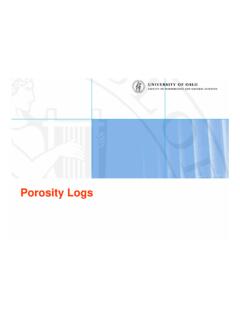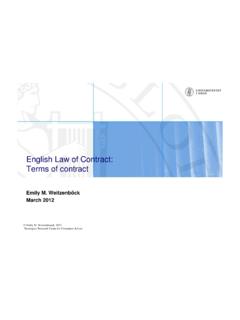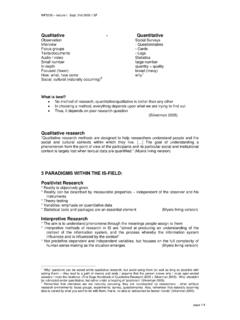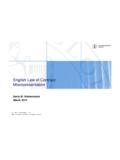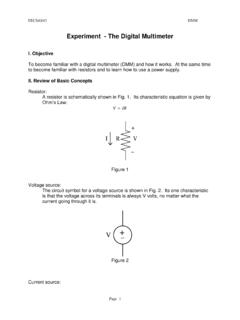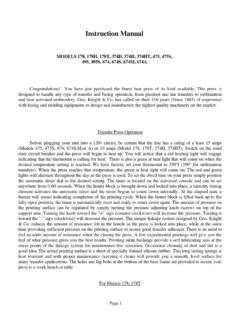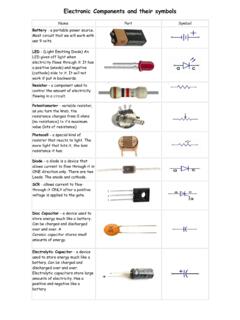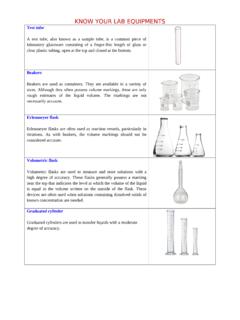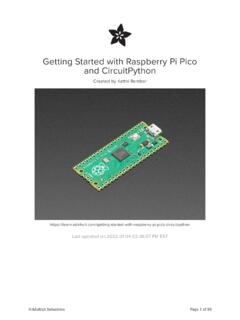Transcription of Arduino Projects Book - Universitetet i Oslo
1 Arduino . Projects . book . THE Arduino Projects book . EDITORS. Projects and text by Scott Fitzgerald and Michael Shiloh Additional text review by Tom Igoe DESIGN AND ART DIRECTION. TODO. Giorgio Olivero, Mario Ciardulli, Vanessa Poli, Michelle Nebiolo DIGITAL FABRICATION AND project MANAGEMENT. Officine Arduino Torino Katia De Coi, Enrico Bassi ADVISORS AND SUPPORTERS. Massimo Banzi, Gianluca Martino, Smart Projects project TESTERS AND PROOFREADERS. Michael Shiloh, Michelle Nebiolo, Katia De Coi, Alessandro Buat, Federico Vanzati, David Mellis THANKS. Big thanks to the entire Arduino user community for their contin- ued contributions, support, and feedback. Special thanks to the Fritzing team: some of the electronic com- ponents illustrations used in the book are taken or modified from the open-source Fritzing project ( ). Heartfelt thanks to Paul Badger for the CapacitiveSensor library used in project 13. The text of the Arduino Projects book is licensed under a Creative Commons Attribution-NonCommercial-ShareAlike License 2012 by Arduino LLC.
2 This means that you can copy, reuse, adapt and build upon the text of this book non-commercially while attributing the original work (but not in any way that suggests that we endorse you or your use of the work) and only if the results are transmitted under the same Creative Commons license. Full license terms: 2012 Arduino LLC. The Arduino name and logo are trademarks of Arduino , registered in the US and in the rest of the world. Other product and company names mentioned herein are trademarks of their respective companies. The information in this book is distributed on an As Is basis without any further warranties. While every precaution has been taken in the design of this book , neither the authors nor Arduino LLC shall have any liability to any person or entity with respect to any loss or damage caused or declared to be caused directly or indirectly by the instructions contained in this book or by the software and hardware described in it. This book cannot be sold separately from The Arduino Starter Kit.
3 Designed, printed and bound in Torino, Italy September 2012. INDEX. 4 00 INTRODUCTION. 20 01 Get to Know Your Tools 32 02 Spaceship Interface 42 03 Love-o-Meter 52 04 Color Mixing Lamp 62 05 Mood Cue 70 06 Light Theremin 78 07 Keyboard Instrument 86 08 Digital Hourglass 94 09 Motorized Pinwheel 102 10 Zoetrope 114 11 Crystal Ball 124 12 Knock Lock 136 13 Touchy-feely Lamp 144 14 Tweak the Arduino Logo 156 15 Hacking Buttons 162 A/Z GLOSSARY. 00. Everyone, every day, uses technology. Most of us leave the programming to engineers because we think coding and electronics are complicated and difficult; actually, they can be fun and exciting activities. Thanks to Arduino , designers, artists, hobbyists and students of all ages are learning to create things that light up, move, and respond to people, animals, plants, and the rest of the world. Over the years Arduino has been used as the brain in thousands of Projects , one more creative than the last. A worldwide community of makers has gathered around this open-source platform, moving from personal computing to personal fabrication, and contributing to a new world of participation, cooperation and sharing.
4 Arduino is open and simple. It's founded on lessons we've learned teaching our own classes: if you start with the assumption that learning to make digital technologies is simple and accessible, you can make it so. Suddenly electronics and code become creative tools that anyone can use like brushes and paint. This book walks you through the basics in a hands-on way, with creative Projects you build by learning. Once you've mastered the basics, you'll have a palette of software and circuits that you can use to create something beautiful, and make someone smile with what you invent. BECOME EXTRAORDINARY. WELCOME TO. Arduino ! Arduino MAKES IT AS EASY AS POSSIBLE. TO PROGRAM TINY COMPUTERS CALLED. MICROCONTROLLERS, WHICH ARE WHAT MAKE. OBJECTS INTERACTIVE. You are surrounded by dozens of them every day: they are embedded in timers, thermostats, toys, remote controls, microwave ovens, even some toothbrushes. They just do one specific task, and if you hardly notice them which is often the case it's because they are doing it well.
5 They have been programmed to sense and control activity using sensors and actuators. Sensors listen to the physical world. They convert energy that you give off when you press buttons, or wave your arms, or shout, into electrical signals. Buttons and knobs are sensors that you touch with your fingers, but there are many other kinds of sensors. Actuators take action in the physical world. They convert electrical energy back into physical energy, like light and heat and movement. Microcontrollers listen to sensors and talk to actuators. They decide what to do based on a program that you write. Microcontrollers and the electronics you attach to them are just the skeleton of your Projects , though. You'll need to bring skills you probably already have to put some flesh on the bones. For example, in one of the Projects we suggest, you'll make an arrow and attach it to a motor, and put them both in a box with a knob, so you can make a meter to tell people whether you're busy or not.
6 In another, you'll put some lights and a tilt switch on a cardboard frame to make an hourglass. Arduino can make your Projects responsive, but only you can make them beautiful. We'll provide some suggestions along the way as to how you might do that. Arduino was designed to help you get things done. To make that happen, we kept the background material on programming and electronics to a minimum. If you decide you want to know more about these aspects, there are lots of good guides available. We'll provide a couple of references, and you can find more online at: 6 Introduction Welcome to Arduino ! + - + - +. + - + - PARTS IN. Breadboard - A board on which you can build electronic circuits. It's like a patch panel, with YOUR KIT. rows of holes that allow you to connect wires and components together. Versions that re- quire soldering are available, as well as the sol- der-less type used here. Capacitors - These components store and re- lease electrical energy in a circuit. When the Arduino Uno - The microcontroller develop- circuit's voltage is higher than what is stored in ment board that will be at the heart of your the capacitor, it allows current to flow in, giv- Projects .
7 It's a simple computer, but one that ing the capacitor a charge. When the circuit's has no way for you to interact with it yet. You voltage is lower, the stored charge is released. will be building the circuits and interfaces for Often placed across power and ground close to interaction, and telling the microcontroller how a sensor or motor to help smooth fluctuations to interface with other components. in voltage. Battery Snap - Used to connect a 9V battery to DC motor - Converts electrical energy into me- power leads that can be easily plugged into a chanical energy when electricity is applied to breadboard or your Arduino . its leads. Coils of wire inside the motor become magnetized when current flows through them. 7. These magnetic fields attract and repel mag- nets, causing the shaft to spin. If the direction of the electricity is reversed, the motor will spin in the opposite direction. - +. Diode - Ensures electricity only flows in one di- Jumper wires - Use these to connect compo- rection.
8 Useful when you have a motor or other nents to each other on the breadboard, and to high current/voltage load in your circuit. Di- the Arduino . odes are polarized, meaning that the direction that they're placed in a circuit matters. Placed one way, they allow current to pass through. Placed the other way, they block it. The anode side generally connects to the point of higher energy in your circuit. The cathode typically connects to the point of lower energy, or to - +. ground. The cathode is usually marked with a band on one side of the component's body. Light Emitting Diodes (LEDs) - A type of diode that illuminates when electricity passes through it. Like all diodes, electricity only flows in one direction through these components. You're probably familiar with these as indicators on a variety of electronic devices. The anode, which typically connects to power, is usually the long- er leg, and the cathode is the shorter leg. Gels (red, green, blue) - These filter out differ- ent wavelengths of light.
9 When used in con- junction with photoresistors, they cause the sensor to only react to the amount of light in the filtered color. H-bridge - A circuit that allows you to control Liquid Crystal Display (LCD) - A type of alpha- the polarity of the voltage applied to a load, numeric or graphic display based on liquid crys- usually a motor. The H-bridge in the kit is an in- tals. LCDs are available in a many sizes, shapes, tegrated circuit, but it could also be construct- and styles. Yours has 2 rows with 16 characters ed with a number of discrete components. each. 8 Introduction Welcome to Arduino ! Male header pins - These pins fit into female sockets, like those on a breadboard. They help make connecting things much easier. potentiometer - A variable resistor with three pins. Two of the pins are connected to the ends of a fixed resistor. The middle pin, or wiper, moves across the resistor, dividing it into two halves. When the external sides of the poten- tiometer are connected to voltage and ground, Optocoupler - This allows you to connect two the middle leg will give the difference in voltage circuits that do not share a common power as you turn the knob.
10 Often referred to as a pot. supply. Internally there is a small LED that, when illuminated, causes a photoreceptor in- side to close an internal switch. When you ap- ply voltage to the + pin, the LED lights and the internal switch closes. The two outputs replace a switch in the second circuit. Pushbuttons - Momentary switches that close a circuit when pressed. They snap into bread- boards easily. These are good for detecting on/. off signals. Piezo - An electrical component that can be used to detect vibrations and create noises. Resistors - Resist the flow of electrical energy in a circuit, changing the voltage and current as a result. Resistor values are measured in Photoresistor - (also called a photocell, or light- ohms (represented by the Greek omega char- dependent resistor). A variable resistor that acter: ). The colored stripes on the sides of changes its resistance based on the amount of resistors indicate their value (see resistor color light that falls on its face.)
